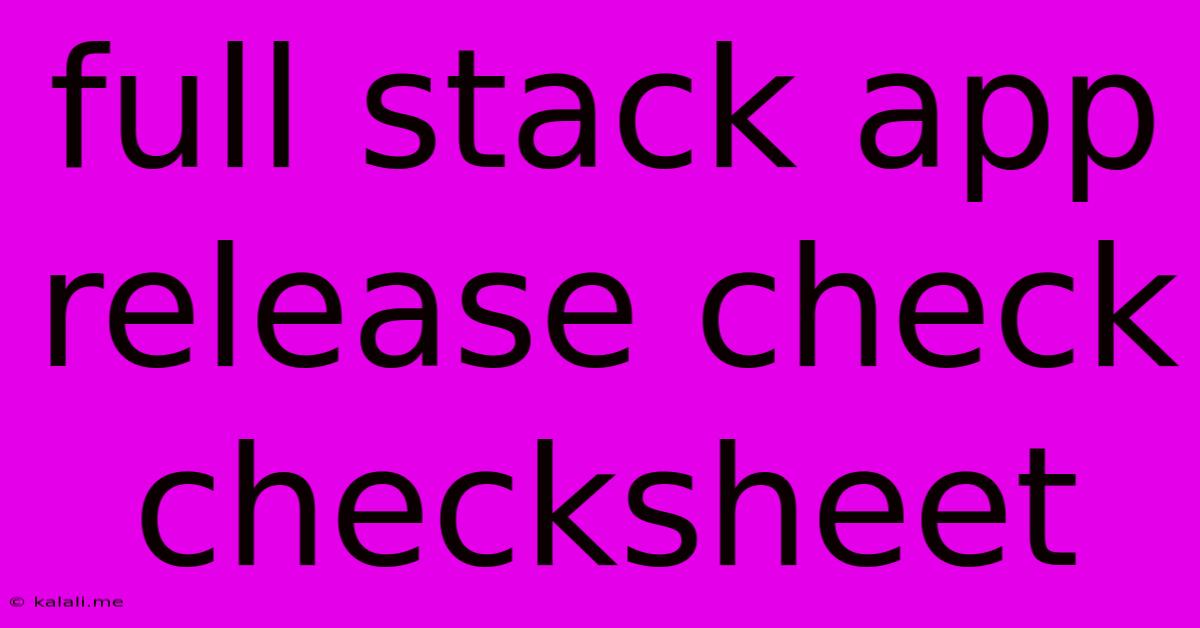Full Stack App Release Check Checksheet
Kalali
Jun 04, 2025 · 3 min read

Table of Contents
Full Stack App Release Checklist: Ensuring a Smooth Launch
Releasing a full-stack application is a significant undertaking, demanding meticulous planning and execution. A single oversight can lead to costly downtime, frustrated users, and reputational damage. This checklist provides a comprehensive guide to navigating the pre-release and post-release phases, minimizing risks and ensuring a successful launch. This guide covers everything from backend infrastructure to frontend user experience, guaranteeing a smooth transition for your application.
I. Pre-Release Checks: The Foundation of a Successful Launch
Before your application even sees the light of day, a thorough pre-release inspection is crucial. This stage involves verifying all aspects of your application, from the server-side infrastructure to the client-side user interface.
A. Backend Infrastructure & Database
- Server Health & Stability: Perform comprehensive load tests to identify potential bottlenecks and ensure the servers can handle anticipated traffic. Monitor CPU usage, memory consumption, and network latency. Consider using tools like JMeter or k6.io.
- Database Integrity: Verify database schema accuracy, data integrity, and backup functionality. Execute data migration scripts and confirm successful data population in the production environment.
- API Functionality: Thoroughly test all APIs, including endpoints, authentication, and authorization mechanisms. Utilize automated testing frameworks and manual testing to cover various scenarios.
- Security Audits: Conduct security scans to identify vulnerabilities and ensure compliance with industry best practices. This includes penetration testing and vulnerability assessments.
- Logging & Monitoring: Confirm that robust logging and monitoring systems are in place to track application performance and identify potential issues in real-time. Integrate with tools like Datadog, New Relic, or Prometheus.
- Deployment Process: Review and test the deployment process itself to ensure a smooth and efficient transition to the production environment. Use a robust CI/CD pipeline for automated deployments.
B. Frontend & User Interface
- UI/UX Testing: Conduct rigorous testing to ensure the user interface is intuitive, responsive, and free of bugs. Employ usability testing with real users to gather feedback.
- Browser Compatibility: Verify application functionality across different browsers and devices. Employ cross-browser testing tools to automate this process.
- Performance Optimization: Optimize the frontend code for speed and efficiency, minimizing load times and enhancing user experience. Utilize tools like Lighthouse to identify areas for improvement.
- Accessibility: Ensure the application is accessible to users with disabilities, adhering to accessibility guidelines (WCAG).
- Internationalization & Localization (i18n/l10n): If applicable, verify that the application correctly handles different languages and locales.
C. Integration & Data Migration
- Third-Party Integrations: Test all integrations with third-party services and APIs, ensuring seamless data exchange and functionality.
- Data Migration (if applicable): If migrating data from a staging environment, execute the migration process and verify data integrity in the production environment.
II. Post-Release Monitoring & Maintenance: Ongoing Vigilance
Even after a successful launch, ongoing monitoring and maintenance are essential. This phase ensures the application remains stable, performs optimally, and adapts to evolving needs.
A. Performance Monitoring & Alerting
- Real-time Monitoring: Continuously monitor application performance using monitoring tools, focusing on key metrics such as response times, error rates, and resource utilization.
- Alerting System: Configure alerts to notify the development team of any performance issues or critical errors.
- Capacity Planning: Based on initial usage patterns, plan for future capacity scaling to accommodate growing user demand.
B. Bug Tracking & Issue Resolution
- Feedback Collection: Implement a robust system for collecting user feedback, identifying bugs, and prioritizing fixes.
- Bug Tracking System: Use a bug tracking system to manage reported issues, track progress, and ensure timely resolution.
- Continuous Integration/Continuous Delivery (CI/CD): Leverage CI/CD to streamline the process of deploying bug fixes and updates.
C. Security Monitoring & Updates
- Security Monitoring: Continuously monitor the application for security vulnerabilities and promptly address any identified threats.
- Regular Updates: Release regular updates to address bugs, improve performance, and enhance security.
By following this comprehensive checklist, you can significantly reduce the risk of problems during and after your full-stack application release, leading to a successful launch and a positive user experience. Remember, meticulous preparation and ongoing vigilance are key to maintaining a healthy and thriving application.
Latest Posts
Latest Posts
-
How To Get Cat Hair Off Clothes
Jun 06, 2025
-
How Much Do I Tip A Barber
Jun 06, 2025
-
Will Super Glue Work On Plastic
Jun 06, 2025
-
Best Paint To Paint A Door
Jun 06, 2025
-
Can You Install Linux Wirh An Sd Card
Jun 06, 2025
Related Post
Thank you for visiting our website which covers about Full Stack App Release Check Checksheet . We hope the information provided has been useful to you. Feel free to contact us if you have any questions or need further assistance. See you next time and don't miss to bookmark.